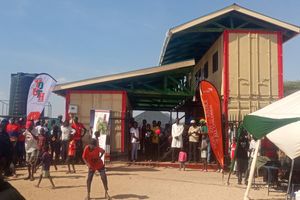
About 43 per cent of children are underweight, and nearly half of the children aged six to 35 months suffer from anemia.
At least Sh21 billion meant to buy relief food during the famine in the last three years cannot be accounted for.
Auditor General Nancy Gathungu has lifted the lid on how the said funds allegedly spent on relief food allocated between 2021 and 2023 at a time when Kenyans faced severe drought cannot be traced.
While the pangs of hunger took a toll on Kenyans, it seems the questionable expenditure may have produced "relief food billionaires" during former President Uhuru Kenyatta's reign, which extended to Kenya's Kwanza regime.
The Special Auditor General's report on government expenditure during emergencies under Article 223 of the Constitution revealed that there were no details of the people who received the relief food.
Ms Gathungu in her report tabled in Parliament revealed that there were no names of recipients, telephone numbers, identification numbers, quantity of food received and signatures of recipients.
"The audit revealed that the distribution lists maintained by the Deputy District Commissioners for food distribution were not complete as they did not contain full details of the persons who received the relief food. As a result, it was not possible to identify the beneficiaries of the relief food distributed," the report said.
During the distribution of relief food, deputy district commissioners were required to submit reports on the relief food distributed to the Department of Special Programs through their respective district commissioners.
However, the auditor's review of the relief food distribution files revealed that 33 of the 34 sampled counties did not prepare and submit returns for the relief food distributed.
"Food distribution records were maintained at the sub-County level. As a result, the ministry did not have information on the relief food distributed for accountability purposes," the audit report revealed.
Ms Gathungu also questioned Sh150,000 that was on paper allocated to counties for logistics of relief food distribution but the devolved units did not receive the funds.
"The audit revealed that the sampled counties did not receive funds for the distribution of relief food.
"As a result, the counties relied on well-wishers to assist in the distribution. In addition, citizens were traveling long distances to collect the relief food due to the non-allocation of funds to transport the food from the distribution point to the sub-county level," the report read in part.
The deputy county commissioners also revealed that the relief food was used as payment in kind to transporters for the food distribution service, reducing the amount available for distribution to vulnerable people.
The report further revealed that in some constituencies, some of the relief food was converted into school fees.
According to the report, families were reselling a bag of rice or beans they received from the government at Sh4,000, which the Auditor General said was below the market price.
"The audit revealed that Buuri East, Tigania West, Chiakariga and Makueni sub-Counties were converting relief food into school fees for needy pupils at a rate of Sh4,000 per bag of rice or beans. This rate was below the market price, which was Sh9,000 for a bag of rice and Sh11,200 for a bag of beans," the audit report said.
However, the report doesn't make it clear whether it was the parents who took the food to the schools in exchange for school fees or the administrators who distributed the food identified the needy families and converted the food into fees.
Ms. Gathungu in her report questioned how the Sh21. 4 billion meant for relief assistance to persons affected by emergencies, disasters and drought in the country was spent.
The funds were released on various dates in the 2016/2017-2022/2023 financial years, spanning both the tenures of former President Mr Kenyatta and his successor William Ruto.
According to the auditor, there were no guidelines for the distribution of relief food that detailed the criteria to be used in identifying people to receive relief food.
"The Ministry of State for Special Programs had general instructions that food should be distributed to vulnerable people in the community, leaving it to the discretion of each county to determine who was a vulnerable person.
"There was therefore a risk that the relief food would be distributed to people who were not vulnerable," Ms. Gathungu said in her report.
There was also a lack of proper storage of the relief food, resulting in the spoilage of some of the food meant to help the needy.
For example, Ms. Gathungu cited Narok East, where there was no storage facility and the relief food was stored in containers that leaked during the rainy season, resulting in spoilage of the food.
"There was a case where five bags of beans were rained on and started to sprout and could not be distributed," the report said.
In Mbeere South, relief food was stored with fertilizer, putting it at risk of contamination.
The audit found that 700 bags of maize were contaminated with aflatoxin and had to be destroyed as unfit for human consumption.









